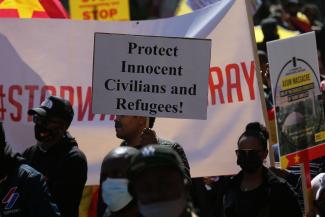Tigray conflict
Eritrean refugees are at risk in Ethiopia
 picture-alliance/ZUMAPRESS.com/Tayfun Salci
picture-alliance/ZUMAPRESS.com/Tayfun Salci
Serious civil strife erupted in Ethiopia in November 2020, pitting the central government in Addis Ababa against the Tigray People’s Liberation Front (TPLF). The TPLF is the regional party that was running the state government of Tigray and had, until a few years ago, dominated the central government. The international public does not get much detailed information on the military operations, but some impacts are only too evident. They include human-rights abuses, hunger and flight (see my comment on the D+C/E+Z platform).
The UN Refugee Agency (UNHCR) counted more than 2 million internally displaced persons (IDPs) in Tigray this summer. However, violence has spread to neighbouring regions too. Relying on Ethiopian sources, for example, the UN speaks of more than 700,000 IDPs in Amhara state, where more than 1 million people depend on food aid. Moreover, several ten thousands have fled west to Sudan.
One group in Tigray’s worst conflict zones is getting very little attention: the refugees from Ethiopia’s northern neighbour Eritrea. Before the current crisis, there were 96,000 of them according to the UNHCR. Many of them had fled governmental oppression in their home country. Eritrea’s despotic regime has been increasingly militarising society since the Ethiopian-Eritrean war of 1998 to 2000, arguing the country is under Ethiopian threat. It recruits people into the military by force, and they must serve indefinitely for very little pay. Others are forced to provide other kinds of services. There are no free elections in Eritrea and fundamental rights such as the freedom of expression or faith are violated systematically.
Eritreans have not only fled to Ethiopia because the country is near. There are also linguistic and cultural affinities as well as family ties. The ethnic group of Tigrinyans, who are at the centre of the current conflict, actually control power both in Tigray and Eritrea, but the two governments hate one another bitterly (see my comment on the D+C/E+Z platform).
The camps are not safe
The new conflict has exposed Eritreans who live in refugee camps in Tigray to brutal and recurring violence. In late 2020, the Ethiopian army relied on Eritrean support to occupy large parts of Tigray. The refugees saw themselves confronted by the very Eritrean troops they had managed not to join by fleeing across the border.
A report published by Human Rights Watch shows how different armed units repeatedly made people in the camps suffer in the months November 2020 to January 2021. Eritrean soldiers executed people they found on lists of wanted people. Moreover, they forced many others to return to Eritrea against their will. On the other hand, militia units from Tigray attacked refugees in cooperation with opposition fighters from Eritrea, claiming to take revenge for alleged plundering.
Hitsats und Shimelba, the two camps closest to Eritrea, have been destroyed completely. Surviving residents had to flee once more – to two camps farther south. These camps have also been hit by armed groups perpetrating violence such as kidnappings and plundering. A new refugee camp, Alemwach, was set up in Amhara in June, but front-line fighting has come threateningly close by now.
Demands for more safety
Even in Addis Ababa, the capital city, refugees do not find peace. Some have staged protests, demanding more safety for themselves as well as their relatives in the conflict region. They say they experience discrimination and attacks. On the one hand, the central government accuses them of backing the TPLF. On the other hand, TPLF supporters resent them because they are Eritreans. The refugees also report that their relatives in the camps have been cut off entirely from aid and communication in the past three months.
Food security has deteriorated dramatically, with hundreds of thousands of people facing famine. As the UN Office for the Coordination of Humanitarian Affairs (OCHA) reported in November, 870,000 people needed food aid in northern Ethiopia. The Eritrean refugees are obviously affected.
An end to the conflict is not in sight. Leaders on both sides have stated they want a military solution. The TPLF troops are controlling increasingly more parts of Ethiopia, and the TPLF leaders have launched a new coalition of opposition factions against Ethiopian Prime Minister Abiy Ahmed, who has stated that the TPLF must be destroyed entirely and has begun to mobilise even non-military people for this purpose. Civilian people caught between the fronts will pay a very high price – and one group concerned is refugees from Eritrea.
Link
Human Rights Watch: Ethiopia: Eritrean refugees targeted in Tigray.
https://www.hrw.org/news/2021/09/16/ethiopia-eritrean-refugees-targeted-tigray#
Markus Rudolf is a Senior Researcher at the BICC (Bonn International Center for Conversion).
markus.rudolf@bicc.de

